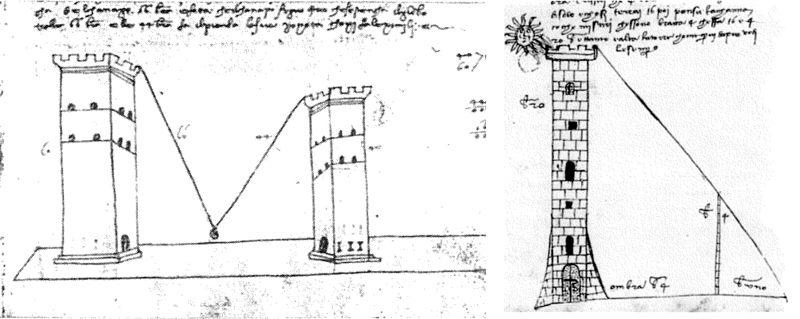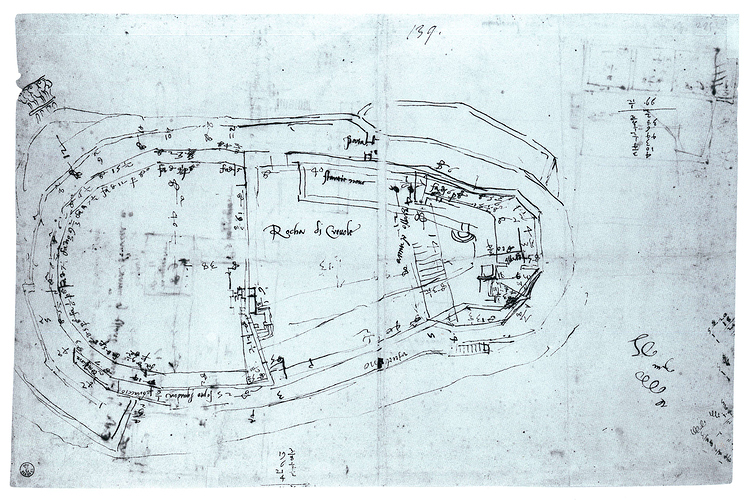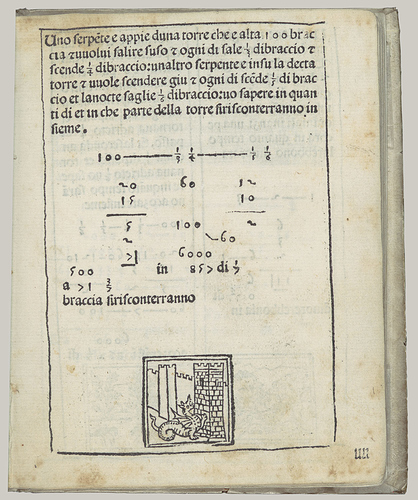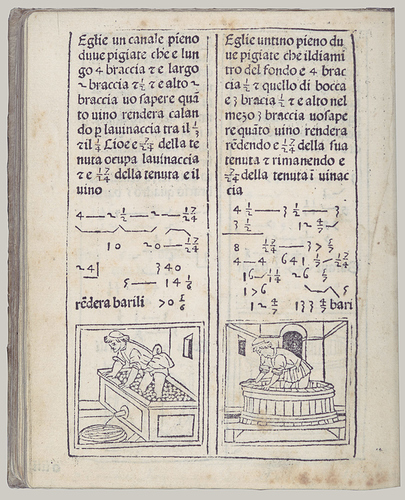SUPERHUMANITY CONVERSATIONS: MARIA S. GIUDICI RESPONDS TO ZEYNEP ÇELIK ALEXANDER, "MASS GESTALTUNG"
Learning by Numbers
Maria S. Giudici
Double tower-distance measurement (1350) and measuring a tower using its shadow (1434-36), from two editions of Paolo Dagomari’s Trattato d’aritmetica. Source: Marvin Trachtenberg, Dominion of the Eye (Cambridge: Cambridge University Press, 1997), 229.
Zeynep Çelik Alexander’s fascinating account of the pedagogical project of Gestaltung explains the way in which formalism became a model for modern education; a model in which the “design of forms and design of the self” coincided. Alexander’s article is a precious contribution as it sheds light on the reason why design as intellectual—and political—category is such an enduring presence and why its roots are more complex than we might think (not to mention steeped in religious convictions just as much as in an ostensible search for rationality). Interestingly, the conjuncture described by Alexander seems to mirror and invert another fundamental moment: if mass Gestaltung posited design as a core category, in the fifteenth century it was the idea of the project that emerged as the keystone of the education of a new urban class through the pedagogical model of the abaco (computing) schools. Contrary to design, project does not necessarily imply a formal resolution: it is a term that is more concerned with the management of things to come. Project implies shaping a direction by handling, influencing, and steering a number of factors we do not necessarily fully control. It is necessarily managerial, and it is more focused on the process rather than the result. It is not by chance that the emergence of a generation of architects and artists who see themselves as authors—and managers—of projects rather than artefacts happens at the very moment and in the very place in which abaco schools flourished: fifteenth century Tuscany.¹
The so-called “Renaissance” is generally portrayed as an intellectual conjuncture fed by humanistic culture and the study of Greek and Latin classics. While this is by and large a correct picture, it is only a partial one, for just as significant as philosophy and literature was the emergence of a pedagogical model heavily based on the command of arithmetic. Abaco schools had existed in all Tuscan towns since at least the thirteenth century, and in most cases they were free and financially supported by the commune or by charitable institutions. Although the very poor could not spare the labor of a healthy ten-year-old boy, the largest part of the urban male population had free access to abaco schools. They were trade-oriented in that they provided a very specific type of technical education. For a period that varied from a few months to a few years, boys aged about nine to thirteen would be trained in arithmetic and geometry through exercises that focused mostly on problems related to commerce, productivity, and military issues. This education allowed lower class enterprising kids to enter trade, but was also useful to the sons of wealthy merchants who initiated the abaco schools in the first place. Conversely, aristocrats would not send their children to abaco, instead preferring to raise them in a more humanistic tradition. Most aspiring craftsmen and artists would increasingly choose to undergo a basic abaco education to acquire computing skills before joining the workshop of an older master: artist, sculptor, goldsmith, architect, engineer, or all of those at the same time. Artists and polymaths such as Baldassarre Peruzzi² and Leonardo da Vinci were raised in this tradition; light on Latin but heavy on managerial concerns.³
The century that followed the 1348 plague had seen the Italian financial and mercantile elite develop increasingly sophisticated accounting methods; not only business was conducted on an unprecedented scale, but a refined division of labor and a novel understanding of risk became the key motivations for the search for mathematical techniques that could minimize loss and maximize profit. Abaco schools became a fundamental element in the development of a class of people who would understand the logic of the budding capitalist system. Abaco students were trained in the use of hindu-arabic numerals, which were championed by Fibonacci in the early thirteenth century but by no means widespread in Europe. In fact, some aristocrats of the time insisted on using Roman numerals as a way to distinguish themselves from people educated in the “trade” tradition of abaco.
Baldassarre Peruzzi, Survey of Rocca di Crevole. Source: Ann C. Huppert, Becoming an Architect in Renaissance Italy: Art, Science, and the Career of Baldassarre Peruzzi (New Haven: Yale University Press, 2015), 42.
Besides their economic role, which cannot be underestimated, and their class connotation, abaco schools introduced a different understanding of the relationship between man and the world. In this sense, the revolution they operated can be compared to the revolution of mass Gestaltung described by Alexander. The universe of the abaco schools is made of quantifiable entities, of objects that the student-subject is supposed to tame, manage, re-produce, and control. The focus is neither on form nor design, but, rather, on the strategic choreography of goods, monetary exchange and labor provision. It is a universe that for the first time is conceived of as without shadow zones: calculable, knowable, open to the preying eye of man. Several of the exercises collected by Florentine schoolmaster Paolo Dagomari in his Trattato d’aritmetica (c. 1360),⁴ relate to spatial issues such as the measurement of distances through triangulation.⁵ This kind of skill would be extremely useful not only to future military engineers, but also to surveyors and architects. Peruzzi, for instance, worked on several projects for dams on the Bruna river, a long-term engineering concern of the city of Siena.⁶ Before Peruzzi, the job had fell on Pietro dell’Abaco, not only one of the most important Tuscan estimators of the time, but also the head of the largest abaco school in Siena during Peruzzi’s youth, making dell’Abaco possibly his very teacher.⁷
Pietro was a teacher and surveyor. His computing skills made him valuable for the city of Siena in calculating the cost of materials and labor for a variety of public works. As Nicholas Adams has noted, this concern for the built environment was very explicit even in the training of abaco students at large, who were often asked to calculate the amount of bricks needed to pave a square, or stones used to build a wall. But even more interestingly, the surveyor also had to be able to forecast the cost of the most uncontrollable of all variables: human behavior. School problems explicitly asked students to calculate the cost and duration of a specific job depending on whether the workers are “lazy” or not. Abaco pushed its students to think as managers, to handle risk and to project costs and revenues, and it is in this cultural tradition that central Italian renaissance architects were by and large educated.
For post-abaco architects, the form of architecture and space would be a response to this attempt to tame reality. Contrary to the form-giving, assertive attitude of mass Gestaltung, post-abaco architects would imagine their designs as a frame to contain the uncertain. The use of classical orders seems, in this sense, an appropriate strategy: as classical orders imply a repetitive grammar, they are, as their very name suggests, “ordered.” Their modular logic escapes the issue of form as they work by addition and subdivision, without the need to create a protagonistic composition. In this sense, the explicitly non-creative tradition of Renaissance abaco is the diametrical opposite of the idea of releasing creativity (and, as Alexander underlines, controlling it at the same time) that informed the German modern pedagogical tradition.
Peruzzi would diligently apply the lessons learned in his numerous site surveys, such as for instance a sketch in which he calculates the length and surface of the wall of the Rocca di Crevole. Baldassarre Peruzzi, Eleventh variation for a dam on the Bruna River. Source: Ibid., Huppert, 47.
Design’s ambition to change its context is very explicit and concrete; the project’s ambition is perhaps less immediate, but by no means less proactive. In fact, we could say that in its managerial attempt to forecast, the project is an inherently more violent undertaking, almost military in nature. The abaco culture is, after all, the culture of a rising capitalism that intends to make productive both land and human lives.
It is, in fact, in the abaco urge to control the land, its ownership, and eventually its productivity that the first seeds of linear perspective find fertile soil. As Panofsky famously remarked, perspective puts forward an infinite, homogenous space. Theological, artistic, and cultural readings of the homogeneity of perspectival space abound, but the earliest uses of perspective as a technique were perhaps more prosaic and linked to the work of the estimator and the surveyor. Perspective finds in the abaco students its ideal vehicle, as they are trained in the geometric and mathematical exercises that form the basis for the construction of the perspectival image. They understand projection and triangulation, and use them as instruments of mapping and colonization.
It is the training of generation after generation of these foot-soldiers of accounting and surveying that allowed for the development of capitalism in central Italy and Europe at large. They are an urban class, a middle class, an early example of white collar work. Interestingly, abaco students would not be confined to warehouses and counting-rooms; they would also become the builders of the physical space of the European city as we know it. They were taught to see reality as a reified array of quantities and they transferred this understanding to the city, which gradually lost its symbolic and ritual meaning to become a field: for harvesting, for battles, for profit. That most crucial form of abstraction—money—was taught to them through endless little mathematical exercises, through which they learned to use abstraction at large as a strategy to handle complex and shifting contexts. Mass Gestaltung is a strong rejection of this form of abstraction, and perhaps a healthy one.
Filippo Calandri, pages from De Arithmetica. Florence: Lorenzo da Morgiani and Giovanni Thedesco da Maganza, 1491. Source
While today abaco students appear to be a consistent class with a consistent culture, they never had any understanding of themselves as a project. Contrary to the Pestalozzi agenda, in the abaco curriculum there is no sense of construction of the self. In the abaco tradition the self is a given; it is the all-encompassing eye of a surveyor, of a map-maker, of a perspectival painter. As is well-known, one of the issues of linear perspective is its failure to convey the fact that human vision is binocular; perspective is conceived as originating in a single, disembodied eye. This is perhaps the greatest fragility of abaco culture: its reliance on increasing levels of abstraction that wipe the subject out of the picture, forgetting that in fact a project is nothing but the shaping of the subject itself.
The very category of project is the legacy of this controversial historical moment—a moment in which ever more sophisticated methods of conquest, control, and colonization are developed, a moment in which the architect is constructed as the opposite of the craftsman, and the intellectual act of projecting is separated from the productive act of designing. To recuperate the very intelligence of design—creation, unmediated by language and convention—is a very understandable response to the problematic consequences of abaco culture. The Pestalozzi genealogy which leads to Gestaltung and ultimately the Bauhaus is representative of such a reaction. It is also understandable how the figure of the craftsman can be conceived of as the antidote to the managerial and abstract character of the modern division of labor. However, as Alexander shows, there can be no design without a project: no action without an agenda. Even mass Gestaltung was guided by profoundly ideological aims. This is the reason to reconsider the idea of project today. In Europe, it was born as a historically-placed response to the emergence of capitalism, where it made it possible to organize labor and reify life into a commodity. If this is a negative heritage we now reject, there are also aspects of the project that can be rethought as means of resistance: the idea that creating a future does not mean necessarily to impose a form, but rather to imagine a set of relationships that can change, shift, readjust. Modern(ist) design culture has often taught us that acts of creation and self-creation are individual, that they happen here and now. But the Renaissance legacy of the project can still be useful in reminding us that in fact these actions are also intensely social, supported and shaped as they are by long-term, broader agendas. The focus on form brought by design offers a concrete edge to our actual engagement with the built world, but the focus on process brought by the project allows us to expand our field of agency to every aspect of life. It is perhaps only in this oscillation between design and project, individual and collective, action and abstraction, that we can reconstruct a position as thinkers and makers today.
×
¹ For a broad portrait of the interaction between abaco schools and art in fifteenth century Tuscany see Michael Baxandall, Art and Experience in Fifteenth Century Italy (Oxford: Oxford University Press, 1988 [1972]), 86-108.
² An interesting comparison between Peruzzi’s working method and that of Michelangelo, who had not been trained in an abaco school, is contained in Giulia Ceriani Sebregondi, “On Architectural Practice and Arithmetic Abilities in Renaissance Italy”, in Architectural Histories, 3(1): 11, 1–15.
³ Baxandall uses examples from Piero della Francesca’s own Trattato dell’abaco (posthumously titled), which does resonate with contemporary abaco textbooks; however, we do not know if Piero had studied at an abaco school, while there is ample proof in Peruzzi and Leonardo’s cases.
⁴ Paolo Dagomari was in fact born in Prato, but active in Florence; he is often referred to as Paolo dell’Abbaco (sic) because of his profession.
⁵ Marvin Trachtenberg, Dominion of the Eye (Cambridge: Cambridge University Press, 1997), 229.
⁶ Ann C. Huppert, Becoming an Architect in Renaissance Italy: Art, Science, and the Career of Baldassarre Peruzzi (New Haven: Yale University Press, 2015), 40-55.
⁷ Nicholas Adams, “The Life and Times of Pietro dell’Abaco, a Renaissance Estimator”, in Zeitschrift für Kunstgeschichte, 48. Bd., H. 3 (1985), 384-395.
Dr Maria Sheherazade Giudici is a Tutor in the School of Architecture at the Royal College of Art, where she currently leads ADS1: The Domestic Imagination with Sam Jacoby and Tarsha Finney. In 2011 Maria joined Pier Vittorio Aureli as Studio Master of Diploma Unit 14 at the Architectural Association. Maria is also the founder of publishing and educational platform Black Square.




